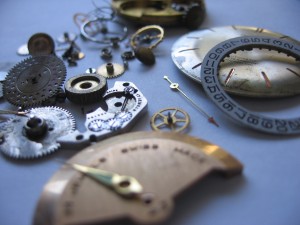Watches have been around and evolved for hundreds of years. Over the centuries, some of the terminology has also evolved, misconstruing certain watch terminology. Here are some often misunderstood watch terms:
Cell
A cell (or power cell) is simply the battery of a watch.
Crystal
The crystal is the clear material on the watch that covers the dial. There are three types of crystals that watchmakers typically use:
- Acrylic: a plastic covering that is easily scratched. Small scratches can be buffed out before a replacement crystal is needed.
- Mineral: a mixture of different elements that create a crystal hard enough to prevent some scratching.
- Sapphire: the hardest type of crystal. It is scratch resistant but not scratch proof.

Water Resistant
Water-resistant watches can handle some moisture but shouldn’t be submerged under water. Rain drops or splashes from washing your hands won’t harm these watches as long as you don’t wear them while swimming. Being water resistant isn’t a permanent condition; it must be maintained to function properly.
Gaskets seal all the openings of the watch. The newer the gaskets are in the watch, the more likely it will stay water resistant. As the gaskets wear out, the watch is more likely to leak. As temperatures change, high-pressure water, soaps and oils will break down the gaskets causing them to be less water resistant over time. When gaskets wear out, we can replace them for you!
Waterproof
Waterproof watches suggest that they can be submerged underwater for long periods of time. But this is a misrepresented term. The only type of truly waterproof watches are certified diving watches.
Are there any other watch terms that confuse you? Stop in, message us on Facebook or call us at (920) 235-4750 and we can answer all of your questions. We hope to see you soon!


